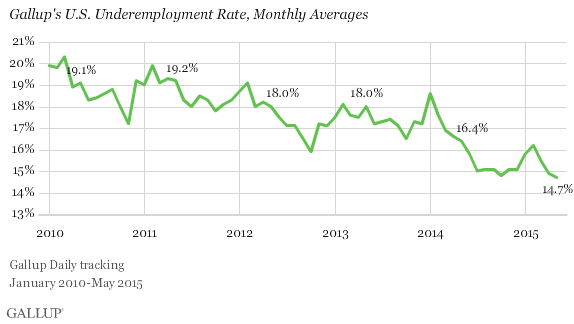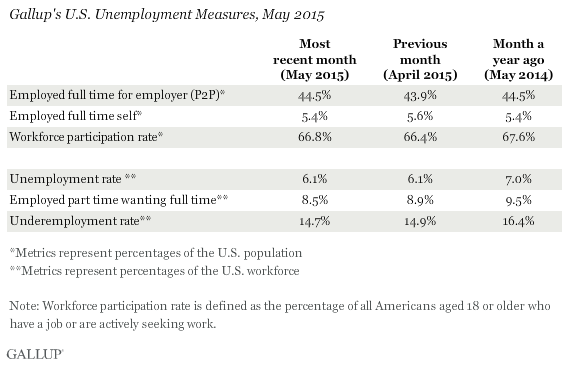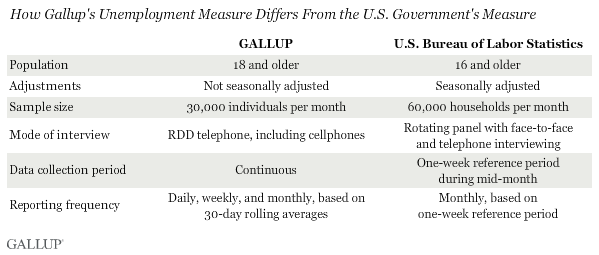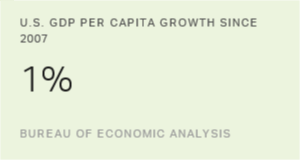Story Highlights
- P2P up 0.6 percentage points from April
- Unemployment steady at 6.1%
- Workforce participation edges up to 66.8%
WASHINGTON, D.C. -- The U.S. Payroll to Population employment rate (P2P), as measured by Gallup, was 44.5% in May. This is up 0.6 percentage points from the previous month, and is identical to the rate measured in May 2014. This represents the strongest month-to-month change for P2P so far this year, in line with an expected seasonal rise in full-time employment.

Gallup's P2P metric tracks the percentage of the U.S. adult population aged 18 and older who are employed by an employer for at least 30 hours per week. P2P is not seasonally adjusted. The latest results are based on Gallup Daily tracking interviews with 31,409 Americans, conducted May 1-31 by landline telephone and cellphone. Gallup does not count adults who are self-employed, work fewer than 30 hours per week, who are unemployed or are out of the workforce as payroll-employed in the P2P metric.
Overall, P2P is an important measure of the health of the economy; of all Gallup's employment categories, P2P tracks most closely with other objective measures of economic productivity such as GDP per capita, as well as with subjective measures such as life evaluations and physical well-being.
Workforce Participation at 66.8% in May
The percentage of U.S. adults participating in the workforce in May was 66.8%. While up from April, this is equal to the March reading. However, it is still 0.8 points lower than the rate measured in May 2014, 67.6%. Since January 2010, the workforce participation rate has remained in a narrow range, from a low of 65.8% to a high of 68.5%, but in the past two years it has most often remained below 67.0%. Workforce participation measures the percentage of adults aged 18 and older who are working, or who are not working but are actively looking for work and are available for employment.

Unemployment Steady at 6.1%
Gallup's unadjusted U.S. unemployment rate remained at 6.1% in May, near the low point in Gallup's five-year trend marked by the 5.8% measured in December 2014. Gallup's U.S. unemployment rate represents the percentage of adults in the workforce who did not have any paid work in the past seven days, for an employer or themselves, and who were actively looking for and available to work.

Unlike Gallup's P2P rate, which is a percentage of the total population, the unemployment rates that Gallup and the U.S. Bureau of Labor Statistics report are percentages within the labor force. While both Gallup and BLS data are based on robust surveys, the two have important methodological differences. Additionally, the most-discussed unemployment rate released by the BLS each month is seasonally adjusted. Although Gallup's employment numbers strongly correlate with BLS rates, the BLS and Gallup estimates of unemployment do not always track precisely on a monthly basis.
Underemployment Continues Slide to 14.7%
Gallup's measure of underemployment in May is 14.7%, the lowest level recorded since Gallup began tracking it daily in 2010. Gallup's U.S. underemployment rate combines the percentage of adults in the workforce who are unemployed (6.1%) and those who are working part time but desire full-time work (8.5%). Combined, these total 14.7% in May due to rounding. The gradual decline in Gallup's underemployment measure has been driven almost entirely by a decline in unemployment, but this month, the 0.2-point decrease was attributable entirely to a lower rate of part-time workers who would rather be working full time. The percentage of the workforce in this category has varied between 10.1% and 8.4% since January 2010.

Bottom Line
Full-time employment for an employer appears to finally be picking up somewhat as summer approaches after a slow start in 2015. Underemployment is as low as Gallup has ever measured and continues to decline, even as one component of it -- unemployment -- is not declining as quickly as it once was.
These are positive signs for the strength of the U.S. labor market, but recovery continues to be slow. The slow pace of improvement may be contributing to weakening economic confidence. Without robust growth in full-time employment and average wages, Americans still aren't feeling enthusiastic about the economy. This, in turn, could be dampening consumer spending even as lower gas prices have put more money in their pockets.
The data in this article are available in Gallup Analytics.


Gallup.com reports results from these indexes in daily, weekly, and monthly averages and in Gallup.com stories. Complete trend data are always available to view and export in the following charts:
Daily: Employment, Economic Confidence and Job Creation, Consumer Spending
Weekly: Employment, Economic Confidence, Job Creation, Consumer Spending
Read more about Gallup's economic measures.
View our economic release schedule.
Survey Methods
Results for this Gallup poll are based on telephone interviews conducted May 1-31, 2015, on the Gallup U.S. Daily survey, with a random sample of 31,409 adults, aged 18 and older, living in all 50 U.S. states and the District of Columbia. For results based on the total sample of national adults, the margin of sampling error is ±1 percentage points at the 95% confidence level. All reported margins of sampling error include computed design effects for weighting.
Each sample of national adults includes a minimum quota of 50% cellphone respondents and 50% landline respondents, with additional minimum quotas by time zone within region. Landline and cellular telephone numbers are selected using random-digit-dial methods.
Learn more about how the Gallup U.S. Daily works.

